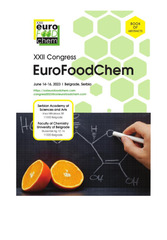Приказ основних података о документу
Effect of dry-heat treatment on acrylamide and HMF formation in maize flour
| dc.creator | Sarić, Beka | |
| dc.creator | Žilić, Slađana | |
| dc.creator | Simić, Marijana | |
| dc.creator | Nikolić, Valentina | |
| dc.creator | AKTAĞ, IŞIL | |
| dc.creator | Gokmen, Vural | |
| dc.date.accessioned | 2023-10-16T07:19:15Z | |
| dc.date.available | 2023-10-16T07:19:15Z | |
| dc.date.issued | 2023 | |
| dc.identifier.isbn | 978-86-7132-083-2 | |
| dc.identifier.uri | http://rik.mrizp.rs/handle/123456789/1180 | |
| dc.description.abstract | Thermal treatments have numerous applications as valuable tools for extending the shelf-life of flour by inactivating enzymes and reducing moisture content [1]. Besides the biological effects, the dry-heat process has a significant impact on the techno-functional, nutritional properties as well as bioactive compounds of flour [2]. However, during different thermal treatments, many potentially harmful compounds could be formed through the Maillard reaction. Recently, two heat-induced contaminants have gained much interest: acrylamide and HMF [3]. HMF forms as a result of the dehydration of hexose sugars or the Maillard reaction during heating [4], while acrylamide in foods is formed via the Maillard reaction from free asparagine in the presence of carbonyl compounds such as reducing sugars during thermal processes. The present study aimed to evaluate the effects of the thermal treatment at different temperatures: 100, 125, 135, 150, and 165°C, on the HMF and acrylamide formulation, as well as the antioxidant capacity of maize flours. The experimental material consisted of three maize hybrids with different colours and kernel types (white-standard, yellow and blue-popping). Maize samples were ground on a lab mill to a fine powder (<500μm) and flour samples were evenly spread thinly on a glass plate and thermally treated for 1 h in a ventilation oven Memmert UF55. In order to evaluate the effect of dry-heat treatment on the HMF and acrylamide formulations and antioxidant activity of maize flours all the results were compared with those of non-treated flours as a control. As we expected, no HMF was detected in untreated flour and the content of HMF increased with the rising of the applied temperature. The content of HMF ranged from 2.93 to 207.60 μg/kg, 2.03 to 113.62 μg/kg and 2.60 to 185.26 μg/kg in white, yellow and blue maize flours, respectively. Our results demonstrated a maximum HMF level at 165°C in the white maize sample (207.60 μg/kg), which was higher by approximately 10% and 45% than the level measured in the blue and yellow maize samples, respectively. The acrylamide ranged from 41.00 to 840.66 μg/kg, 31.40 to 666.70 μg/kg and 56.75 to 953.96 μg/kg in white, yellow and blue maize flour samples, respectively. It was observed that the dry-heat treatment of all the investigated products at higher temperatures produced slightly more acrylamide concentrations. No acrylamide was detected in untreated flour, as well as in maize flours heated at 100oC. The antioxidant capacity ranged from 10.05 to 13.32, 15.89 to 18.15 and 20.51 to 24.03 mmol Trolox Eq/kg in white, yellow and blue maize flour, respectively. Dry-heat treatment had a significant effect on the maize flour colour parameters and the results of the parameters L*, a*, and b* indicated that the flour showed a darkening and browning effect as the dry-heat treatment temperature increased. Browning also indicates the formation of melanoidins as the end-product of the Maillard reaction, which confirms the maximum value of antioxidant capacity at a temperature of 165°C. All results showed that dry heat treatment increases antioxidant capacity with increasing temperature, but also increases HMF and acrylamide. However, due to the different kernel structures of the used maize genotypes and the inter-relations between chemical compounds within the food matrix, the overall impact of dry-heat treatments was not completely elucidated. | sr |
| dc.language.iso | en | sr |
| dc.publisher | Beograd : Srpsko hemijsko društvo | sr |
| dc.relation | info:eu-repo/grantAgreement/MESTD/inst-2020/200040/RS// | sr |
| dc.rights | openAccess | sr |
| dc.rights.uri | https://creativecommons.org/licenses/by/4.0/ | |
| dc.source | XXII Congress, European Food Chemistry – EuroFoodChem, June 14-16, Belgrade Serbia, Book of Abstracts | sr |
| dc.subject | thermal treatments | sr |
| dc.subject | acrylamide | sr |
| dc.subject | HMF | sr |
| dc.subject | maize flour | sr |
| dc.title | Effect of dry-heat treatment on acrylamide and HMF formation in maize flour | sr |
| dc.type | conferenceObject | sr |
| dc.rights.license | BY | sr |
| dc.citation.spage | 276 | |
| dc.identifier.fulltext | http://rik.mrizp.rs/bitstream/id/6309/bitstream_6256-276.pdf | |
| dc.identifier.rcub | https://hdl.handle.net/21.15107/rcub_rik_1180 | |
| dc.type.version | publishedVersion | sr |


